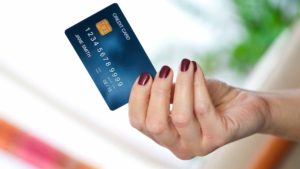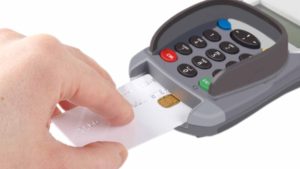If you cannot use credit responsibly, the common advice you are given is to simply chop up your credit card and use only cash for purchases. But what if you are a responsible credit user working your way to become a PAW? Then, I have a better suggestion for you. Chip up your credit card. What? Read on…
Simplifying your life starts with…well, simple things. But simplicity should not come at the cost of security. The U.S. financial product industry has often put convenience far ahead of security. As a result, consumers and the society pay a needlessly high price. You may be accruing points, cash back rewards and airline miles on your credit card but are you compromising your security doing so? Credit card usage is increasing every day but are you safe from credit card fraud? If you still have a magnetic swipe credit card, you are at considerable risk every day for using it.
Here are the startling facts from The Nilson Report on which my analysis is based:
- Global fraud on credit cards, debit cards and prepaid cards have caused annual losses of $16.31 billion on a total card sales volume of $28.84 trillion. In other words, 0.056% of all transactions are totally fraudulent – don’t let the low percentage fool you. If you are moving trillions of dollars, this is huge.
- U.S. fraud losses increased to 12.75 cents for every $100 in volume annually. The U.S. alone causes 48.2 percent of fraud losses worldwide but only has 21.4 percent of the overall global card sales volume. Think about this for a second, U.S. does less than a quarter of the world’s credit card transactions, but contributes nearly half of the total fraud losses! Put another way, there is a nearly 13 cent ‘tax’ on every $100 you spend, which the credit card company will pass on to you via higher interest rates.
- U.S. card issuers lost an estimated $3.9 billion due to counterfeiting, which accounted for 24 percent of global fraud losses in this category. Once again, the U.S. leads the way for counterfeiting loss, which is easy with the way credit cards are made and used.
When you dig deeper here, you will know why our country leads the statistics in this largely preventable consumer fraud situation with credit cards. The main reason is the huge premium people put on convenience – above all else – in U.S. This creates a prime ground for fraud.
You walk into a store, pick up your stuff and just hand your card to the cashier, who blindly swipes the card without even checking if it is signed on the back or not (card is technically not valid unless signed, but nobody cares). Even if it is signed, nobody checks whether your signature on the printed receipt matches what’s on the card. The clerk proceeds to the next customer and you go on about your merry way. More than a billion credit card transactions happen like this every day.
This is a huge opportunity for crime.
The rest of the world has moved far ahead compared to the U.S. when it comes to credit card security. Today, you cannot make credit card purchases in Asia and Europe without the ‘chip card’ or ‘EMV chip’ card, as it is called. The EMV name comes from the first letter of Europay, Mastercard and Visa – three industry giants who came together and created a new credit card security standard, which is now adopted by most of the world. An EMV chip card looks exactly like any credit card except that it has a small golden microprocessor chip on the front, above the embossed card number. And unlike vertically-swiping cards, this EMV card is inserted right into the reader horizontally, with chip side facing up. The embedded chip on the card authenticates the transaction. The reader shows a signature pad on the machine, and you may be asked to sign like a normal paper but this is captured on the screen. The card must stay in the reader till the authorization is complete (unlike the swipe and remove of traditional credit cards).
Conventional magnetic stripe credit cards are encoded with static consumer and payment information. EMV cards contain a computer chip, essentially a microprocessor and transmitter. Unlike magnetic stripe credit cards that are static in nature, the information contained on these chips changes frequently. Each transaction creates a unique transaction code (called “token”) using cryptography (think top-secret military codes and complex code-breaking algorithms like in A Beautiful Mind). No two transaction tokens are repeated, so each token becomes useless after completing the transaction that it was created for.
This new EMV chip card is now making its way across the U.S. You may already have it; if not, you would be receiving it shortly from your card provider. While this is better than the old magnetic cards, the method that U.S. is adopting is not the most secure way. U.S. credit cards with the EMV chip now being gradually introduced are with the ‘chip and choice’ feature. This is inferior to the far more secure ‘chip and PIN’ feature used in Asia and Europe.
Chip-and-choice essentially means that even after using your chip card, you will be asked to complete the transaction only with a signature. This is, in other words, a chip-and-signature transaction, and is essentially identical to what you do with magnetic swipe cards. I don’t know why the U.S. card issuers are not insisting on the far more secure ‘Chip-and-PIN’ transaction. Here, once the cashier inserts the EMV chip card into the reader and punches in the transaction details, the entire reader is then given to you – the buyer – to privately enter a secret 4-digit number that only you will know. This is similar to how you withdraw cash from an ATM using your debit card. Only if the number matches what’s on record with the card company will the transaction go through.
It will be impossible for a thief, if he even has your credit card, to be able to make purchases with it if the entire marketplace uses Chip-and-PIN transaction method. Yes, it is a bit inconvenient to enter your PIN every time you make a purchase, but wouldn’t this just be a tiny inconvenience to make your purchase secure? So, if you have received your new credit card, call your card issuer now and see if you can convert your credit card to Chip-and-PIN. It is far safer for you and also for the card issuer.
These small things give you peace of mind as you progress in your quest for financial independence. The last thing you want is a security risk from a financial tool that most of us use daily. Before you make your next purchase, chip up your credit card. Travel safely, my 10! friends.
Raman Venkatesh is the founder of Ten Factorial Rocks. Raman is a ‘Gen X’ corporate executive in his mid 40’s. In addition to having a Ph.D. in engineering, he has worked in almost all continents of the world. Ten Factorial Rocks (TFR) was created to chronicle his journey towards retirement while sharing his views on the absurdities and pitfalls along the way. The name was taken from the mathematical function 10! (ten factorial) which is equal to 10 x 9 x 8 x 7 x 6 x 5 x 4 x 3 x 2 x 1 = 3,628,800.




10 comments on “Chip Up Your Credit Card”